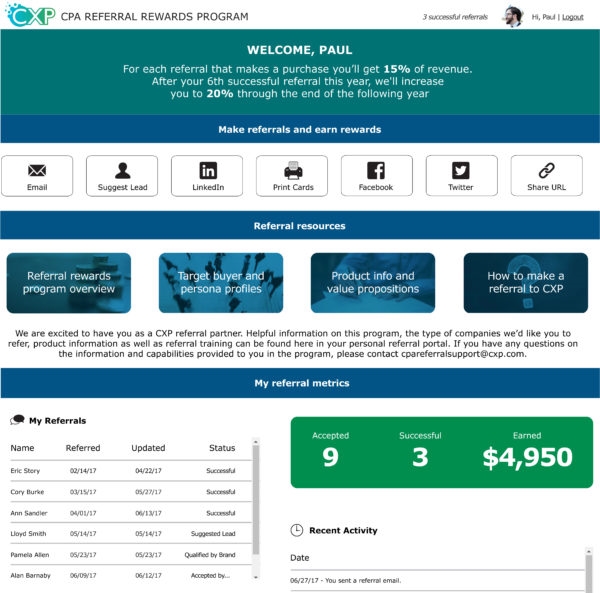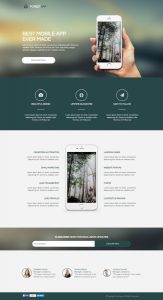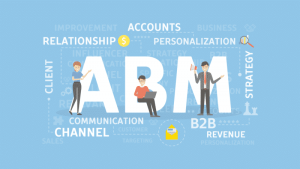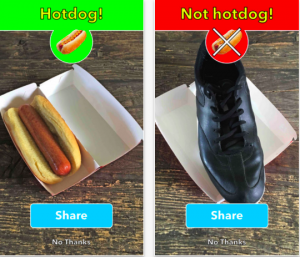— July 19, 2017
The next step in building your referral partner channel is to ensure that you are enabling referral partners with all of the information and capabilities they need to be successful. Right after registering, the referral partner should be sent to a personal referral portal that enables them to get all the information they need from you to make a referral, provides them the mechanisms to make referrals and transparency into their referral and reward stats.
Deliver referral partners a personal referral portal with:
- Multiple ways to easily make referrals
- Product content to educate and to share
- Information on target buyer including personas
- Clear rules for earning incentives
- Transparency into referral activity and reward status
- Training materials on the program and how to make referrals
1. Provide multiple ways to easily make referrals
According to, The State of Business Partner Referral Programs – Annual Report, there are six methods that partner programs utilize to make referrals with varying degrees of use and success (see chart below). Poll your partners to determine the ways they connect with their network/your target buyers. For instance, which social media channels would make sense to offer? Minimally, you’ll want to offer Lead form, shareable urls and a way to collect verbal referrals as staples for your program. These are the most successful methods at driving leads that turn into new business. Here are the six referral methods:
- Lead form – a form filled out with contact info once your referral partners have had a conversation with prospects to qualify them.
- Verbal referrals – if direct or partner sales teams are involved in recruiting referral partners and collecting referrals, make sure you have the mechanism to collect this information and input it into your referral system to be tracked.
- Email – Provide emails preloaded with your value proposition that a referral partner can then personalize and send to their contacts.
- Shareable URL – provide the ability to create a personal, trackable referral link that partners can place on their LinkedIn profile, business website, email signature, blog post or in a direct text message.
- Social media – If your referral partners are connected to your target buyers via social media, then give them the tools to share your value proposition in social media. The more functionality you can provide to allow them to post/message to an individual, the better results you’ll get.
- Print cards – A printed referral card with the personal url/tracking code on it can be a great way to bring offline conversations on line. With the value proposition already on the card, this can be an excellent leave behind for face-to-face encounters.
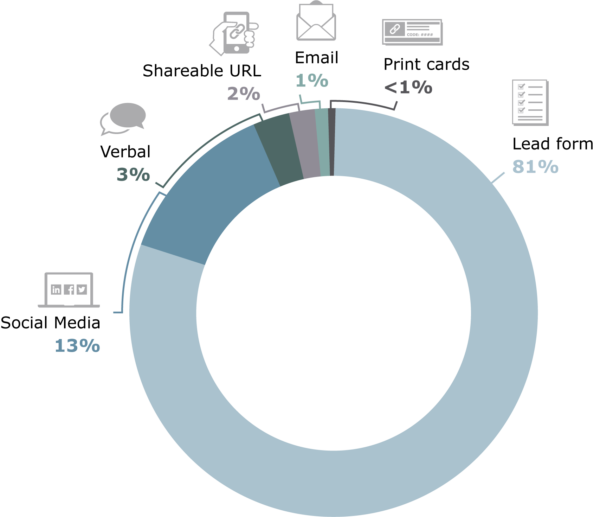
Most used referral methods by partners, The State of Business Partner Referral Programs – Annual Report
2. Give them product content to educate and to share
The best way to ensure that your value proposition is reaching the referral is to lock it into the referral methods. Additionally, you’ll want to provide key content pieces that your referral partners can share as well as content to educate your partners enough to qualify for fit and make the recommendation. Don’t overwhelm, just provide the key staples in simple, easy to digest format. At the bare minimum, provide a pdf overview as well as an explainer video.
3. Clearly define your target buyer and provide persona profiles
The quality of referral leads are only as good as the information you provide your partners on who you want in your pipeline. Right on their personal referral portal you’ll want to give them the following information:
- Target company profile: Industry, size, relevant technographics, any known triggers for needing your product or service.
- Key personas within the target company: department, titles, job responsibilities, role as influencer, buyer, champion, etc.
Make this information easy to access – I recommend on the portal homepage – and easy to understand (use graphics and videos).
4. Provide clear rules for earning incentives
The best way to get activity from referral partners is to make them very aware of the value they get in making the referral. Yes, this may help position them as a trusted adviser and allow them to add value to existing customers, but fundamentally this comes down to the referral fee. Referral partners need to clearly understand the incentive and any hoops they need to jump through to earn it (I’ll cover incentive models in the next article in the series). Blatantly advertise the incentive on their personal referral portal and spell out any rules so that there is no confusion or argument over achievement. And if you’ve got a specific SLA or stretch goal, show them where they are on their way to achieve it.
5. Provide transparency into referral activity and reward status
The last thing you need is to be fielding emails and calls from partners wondering where their reward is. Enable all of the referral tracking to flow in real-time to their personal referral portal. Also, send an email when a referral changes status so that your partner is aware. The data in their portal should include:
- All referral activity – who they’ve made referrals to and which referrals are still open, have been accepted or rejected.
- Referral status – once a referral is accepted and qualified, make sure they can see the progress through the pipeline so they can help support the process.
- Successes – when a referral makes a purchase, notify them of this via email, but also show this in their portal as well as the incentive earned.
- Reward fulfillment – provide the details on the payment of rewards earned.
6. Provide training materials on the program and how to make referrals
I cover training in a future article for onboarding referral partners. But fundamentally, there is no way you will be able to personally train each referral partner. Make sure you include in their personal referral portals training videos/materials on the following:
- The rules for earning incentives
- The target buyer profile – including personas
- How to make a one-to-one referral ask
- The ways to input referrals into tracking system
- Info on what happens to a referral lead once they provide it
- How to access referral activity data and reward fulfillment status
Use technology to enable referral partners
Using technology to enable referral partners is key to getting the scale needed to impact company revenue. Make sure the technology you select makes it as easy as possible for you to deliver these capabilities and information to your referral partners. Additionally, make sure it is white labeled and integrated via SSO into your web properties so that it is a seamless experience for your partners.
Once you’ve got the key enablement pieces in place, you’ll want to build a motivating incentive structure for your partners. I’ll cover best practices for structuring incentive models and fulfillment for referral partners in the next article in this series.
Business & Finance Articles on Business 2 Community
(77)
Report Post